We won’t forget August 10, 2020. On that summer day, Cedar Rapids was hit with 140 miles an hour winds that tore off roofs, felled signs, and toppled at least 65% of the City’s trees. The damage was awesome.
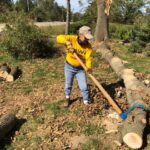 We lost 47 of our 53 big trees at Winding Pathways and spent the next two months cutting up a twisted jumble of trunks and branches. We bucked up what we could for firewood and made huge brush piles on the north end of our property for wildlife habitat. We used chain saws for cutting but muscle power to haul brush and wood.
We lost 47 of our 53 big trees at Winding Pathways and spent the next two months cutting up a twisted jumble of trunks and branches. We bucked up what we could for firewood and made huge brush piles on the north end of our property for wildlife habitat. We used chain saws for cutting but muscle power to haul brush and wood.
Nearly all woodland owners suffered similar damage, and most of them immediately began clearing away broken and downed trees. Some used heavy equipment to haul off debris, leaving bare soil in the woods, a perfect seedbed for weeds.
Resetting the Forest
The derecho reset Iowa’s woods. Prior to settlement most of the state was prairie with woodlands typically lining streams and rivers. Frequent wildfires raced through grasslands and never hesitated when they encountered woods. This created a savanna ecotype characterized by scattered fire-resistant big trees, mostly oaks, walnuts, and hickories, with a stunningly diverse array of wildflowers carpeting the ground.
Savanna was an “open” forest. It lacked a shrub understory, and because trees didn’t create a closed leafy canopy sunlight dappled the ground. Perhaps no forest is as beautiful or endangered as savanna.
Iowa’s settlers quickly suppressed fire. Gradually trees closed the canopy, keeping the ground in shade most of the day. Many savanna flowers need some sunlight and declined as a shrub layer, often of exotic invasive woody plants, thrived. Many woods that owners considered healthy were actually degraded by years of fire protection.
The derecho changed it within under an hour. Many trees fell to the ground, but others survived. Woodlands will now have sunlight reach the ground, stimulating both invasive species and long-suppressed native wildflowers.
Planning and Planting
The woods on the east side of our house created nearly a complete canopy, but suddenly they fell. After we cleared away the debris, we did these things:
- Planted a few white and bur oaks in the fall. We’ll plant a few more next spring. All are protected from deer browsing with a stout ring of wire mesh.
- Purchased a diverse mix of savanna wildflowers and a few kinds of grass from Pheasants Forever. Mid-November brought two inches of new snow, and we hustled out to broadcast the seeds on it. It’s called frost planting and works well.
- Discovered some tiny oaks, hackberries, and walnuts amid fallen trees. We marked them and know they’ll grow rapidly next year.
Recovery will be slow. Newly planted trees grow slowly their first few years and savanna and prairie seeds take a few years to establish. We don’t expect to see much change in 2021 but our “new” savanna will eventually be gorgeous and look much like it would have in the early 1800s.
Sources
We bought our prairie seed from www.pheasantsforever.org. Our fall-planted trees were ordered from the National Arbor Day Foundation www.arborday.org. Spring planting will be of trees we bought from Chief River Nursery www.chief rivernursery.com.
- Trimming damaged trees.
- Arbor Day in November
- Discovering volunteer seedlings
- Rich planting acorns gleaned from an undamaged timber patch
We’ll follow up our planting with occasional prescribed burns to retard invasive plants and invigorate natives.

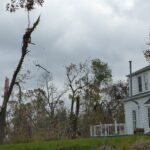
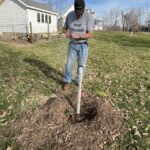
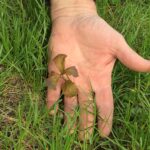
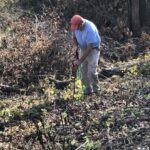

Nicely explained. I appreciate how you manage to find a bright side to the derecho without being annoyingly Pollyanna. 🙂
Thanks, Kathleen!
Thanks, Kathleen.
It will be interesting to compare notes next year- I bought a savanna seed mix from Prairie Moon nursery for my formerly-wooded bald spot. We hired tree trimmers with big-boy toys to do the work I can’t do, and although I asked to just have trees and branches cut up and left, they couldn’t resist scraping the ground bare. No doubt they thought they were doing me a favor so I could plant some turf grass there. (Eye-roll)
Although I have much of my gardens spaces planted in natives, I’ve never direct seeded an area, so this is a new adventure for me!
Yes, Karla, let us continue to watch this and report on progress. thanks.